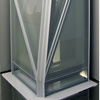The Skyscraper Museum is devoted to the study of high-rise building, past, present, and future. The Museum explores tall buildings as objects of design, products of technology, sites of construction, investments in real estate, and places of work and residence. This site will look better in a browser that supports web standards, but it is accessible to any browser or Internet device.
The Bank of America Tower at One Bryant Park
A 5.1-megawatt cogeneration plant will supply 70% of the building's energy with a clean natural-gas burning power plant. For climate control, it will rely on a ground- water heat exchanger that is the first of its type and will make ice with excess thermal energy from the power plant, supplementing the air conditioning system and reducing the peak demand loads on the city's electrical grid.
The building will save 10.3 million gallons of water annually through such devices as waterless urinals and low-flow fixtures. A gray water system will capture, store, and re-use 100% of rainwater and recycle waste water and planted roofs, reducing the urban heat island effect. Bottom line, the Bank of America Tower will reduce energy consumption by 50%, potable water consumption by 50%, and create net zero carbon dioxide emissions.
A 5.1-megawatt cogeneration plant will supply 70% of the building's energy with a clean natural-gas burning power plant. For climate control, it will rely on a ground- water heat exchanger that is the first of its type and will make ice with excess thermal energy from the power plant, supplementing the air conditioning system and reducing the peak demand loads on the city's electrical grid.
The building will save 10.3 million gallons of water annually through such devices as waterless urinals and low-flow fixtures. A gray water system will capture, store, and re-use 100% of rainwater and recycle waste water and planted roofs, reducing the urban heat island effect. Bottom line, the Bank of America Tower will reduce energy consumption by 50%, potable water consumption by 50%, and create net zero carbon dioxide emissions.







